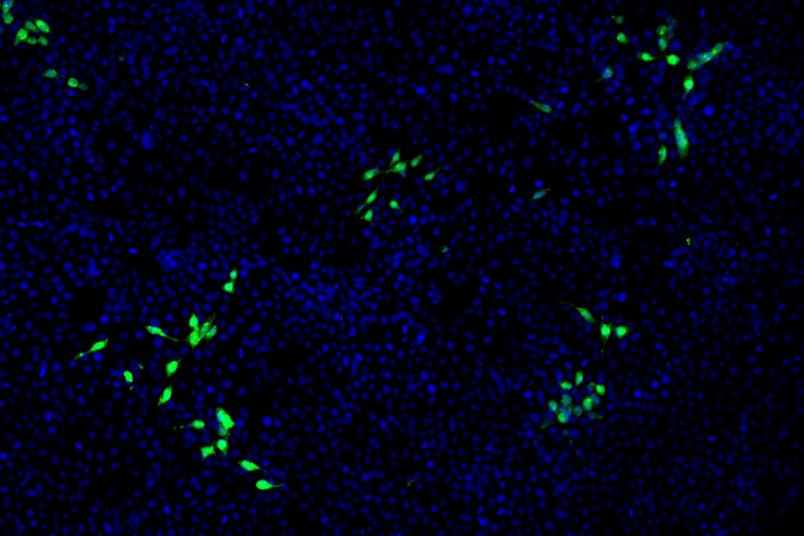
Kidney cells infected with HEV are marked with a green fluorescent dye. Non-infected cells are stained blue.
Virology
Virus on the loose
A research team from Bochum and Hannover shows that the hepatitis E virus also attacks organs other than the liver.
The hepatitis E virus (HEV) causes severe liver inflammation. A research team from Ruhr University Bochum, Germany, and TWINCORE, the Centre for Experimental and Clinical Infection Research in Hannover, has now been able to prove for the first time that it can also infect kidney cells and replicate there. Antiviral drugs such as ribavirin are less effective there than in the liver. The results of the study have now been published in the journal Liver International on June 27, 2025.
Entire life cycle possible in the kidney
Hepatitis E viruses mainly infect liver cells and cause the most damage in the liver. “However, it was already known that they can go down the wrong path and infect other cells, such as nerve cells,“ says last author Dr. André Gömer from the Department of Molecular and Medical Virology at Ruhr University Bochum.
The team from Bochum and Hannover has now succeeded in proving in cell culture that the viruses also infect kidney cells and can multiply with their help. “The entire replication cycle of the virus takes place in kidney cells in the same way as in liver cells,“ says Gömer.
The infected kidney cells responded less well to treatment with the antiviral drug ribavirin than the liver cells. “This is probably due to the significantly different metabolic profiles of the two organs,“ says Gömer. In the kidney, the virus is therefore relatively insensitive to drug treatment.
“It could be that in chronic infections, the kidney acts as a reservoir from which the viruses spread again after a supposedly successful treatment,“ says Nele Meyer, a PhD student in the Translational Virology research group at TWINCORE. She and the physician Avista Wahid are the first authors of the study. Such a reservoir could also enable the viruses to adapt better to treatment.
Evolution in the organ
The team also conducted a comparative genetic analysis of hepatitis viruses from chronically infected patients using their blood plasma, stool and urine. While viruses are mainly excreted from the liver in the stool, those from the kidneys are found in the urine. ‘The viruses found in the different samples differ significantly from each other,“ reports Dr Patrick Behrendt, head of the Translational Virology group at TWINCORE and also last author of the article. “This indicates that the populations have been developing independently of each other for some time and have undergone a kind of evolution in the respective organ.“
The Hepatitis E Virus